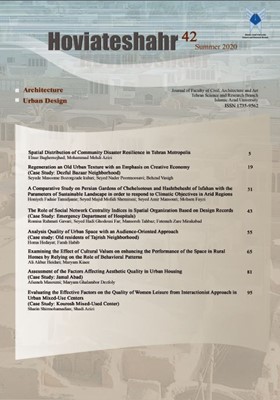-
-
List of Articles
-
Open Access Article
1 - Spatial Distribution of Community Disaster Resilience in Tehran Metropolis
Elnaz Baghernejhad Mohammadmahdi Azizi -
Open Access Article
2 - Regeneration an old urban texture with an emphasis on creative economy (Case Study: Dezful Bazaar Neighborhood
Seyede masoome Bozorgzade kuluri Seyed nader Poormoosavi Behzad Vasiq -
Open Access Article
3 - A Comparative Study on Persian Gardens of Chehelsotoun and Hashtbehesht of Isfahan with the Parameters of Sustainable Landscape in order to respond to Climatic Objectives in Arid Regions
Honey Fadaie Tamidjanie Seyed Majid Mofidi Shemirani Seyed Amir Mansouri Mohsen Faizi -
Open Access Article
4 - The Role of Social Network Centrality Indices in Spatial Organization Based on Design Records (Case Study: Emergency Department of Hospitals)
Romisa Rahmati Gavari Hadi Ghodousi Far Mansoureh Tahbaz Fatemeh Zare Mirakabad -
Open Access Article
5 - Examining the effect of cultural values on enhancing the performance of the space in rural homes by relying on the role of behavioral patterns
Ali Akbar Heidari Maryam Kiaee -
Open Access Article
6 - Assessment of the Factors Affecting Aesthetic Quality in Urban Housing (Case Study: Jamal Abad)
Afsaneh Masumi Maryam Ghalambor Dezfuly -
Open Access Article
7 - Evaluating the Effective Factors on the Quality of Women Leisure from Interactionist Approach in Urban Mixed-use Centers (Case study: Kourosh mixed-used center)
Sharin Shirmohamadian Shadi Azizi -
Open Access Article
8 - Analysis Quality of Urban Space with an Audience-Oriented Approach
Homa Hedayat Farah Habib
-
The rights to this website are owned by the Raimag Press Management System.
Copyright © 2021-2025







